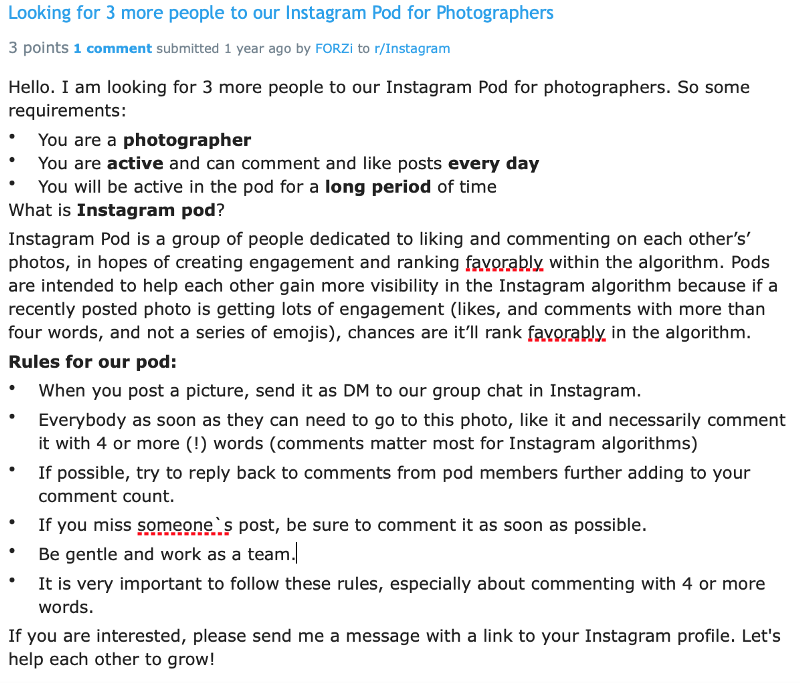This guide will tell you everything you may want to know about Instagram engagement pods and how to best “hack” the algorithm so you can participate in them.
What is an Engagement Pod?
The idea behind the engagement pod is to get more exposure, for a variety of reasons (more on that later).
Here’s how it works: Groups of people (or businesses) join together and agree to consistently access each other’s content and engage with that content, through likes, comments, and sharing. The goal is to spread that content over a wider audience, because of the performance of each post.
There are many strong advocates of pods, as well as others who claim it really is too time-consuming and has a negative effect. The only way for you to tell if this strategy works for you is to try it and see for yourself.
Why Would a Brand Want to Participate?
Again, the purpose is to increase engagement and exposure.
So, let’s look at how the Instagram algorithm works. When a brand publishes a post, Instagram will serve up that post to only a percentage of your audience. If the post performs well with that small %, then your post receives a “score.” This can determine a greater “serving up” and also its place in the “discover” tab.
What you can do by using pods, is increase the performance of your posts and thereby increase your “score.”
By using pods, users can increase the volume of engagement they are receiving in the small testing window, and therefore increasing your content’s “score.”
For brands, the benefits can be as follows:
- An increase in the post ending up in “Discover”
- Chance to make new connections
- Increase in the number of likes and comments
Pods Come in All Shapes and Sizes
Pod sizes can range from 20–1000 or more. And there are very specific types with “rules” for joining and keeping your “membership.”
- Niche Pods: These pods are usually smaller and rather exclusive. And these may be very attractive for your brand if your goal is to gain wider exposure related to potential customers in your business niche. They are also harder to find and to get into.
- Broad Pods: These are large, not as focused, have fewer rules, and are easier to find and join. However, in terms of promoting your company, it’s a bit like throwing huge amounts against a wall and hoping some of it sticks.
- Entry Requirements: Some pods require that a member have a certain number of followers before they can join; some have rules about when and how to post and to “like and comment” the posts of others; some will charge a fee to join.
- Rolling/Drop/Groups: These pods each have different “rules.” A Rolling pod will usually require that you engage with a set number of posts prior to being able to post your own. Drop pods provide specific times that must be shared, and members are required to engage with all other members who dropped posts at that time. Group pods are far more flexible. Members are asked to engage with posts and can share their posts at any time.
Finding Pods to Join
Instagram pods are rather secretive and it may be difficult to find them. Other social platforms offer pods that are less secretive. They are usually very large and not specific to any business niche. These are not recommended, because you are really not reaching your specific audience.
So, how do you find these smaller, niche pods that can benefit your brand? There are a number of ways, but they all take time:
- Network, network, network: You need to search through Instagram to find other users who are in yours and related niches. Connect with them and develop relationships. You may ultimately be given access to a pod they may be in.
- Locate influencers in your niche. Again, develop relationships so that they may give you access to any pods they may be in.
- Join groups on Facebook that are related to Instagram, and network with those members
- Go to Instagram Subreddit and search for pods. Here is an example pod member request posted on Subreddit, specifically related to the photography niche.

Are they Worth It?
The verdict is still out on pods. Here are the downsides:
- They take a lot of time; the time you might want to spend on other marketing activities.
- The likes and comments you get, if you are in a large pod, are really not going to get you lots of new customers. Too many members are not really interested in your business — they are just self-promoting.
7 Tips for Benefitting from Pods
On the other hand, if done right, there can be some benefits. So, here are some strategies that can bring those benefits.
- Join a Few Pod Types at First
You may have to experiment with all three types of pods and see which type gives you the kind of “play” you want. But, if you are a brand looking to spread the word to a specific audience, you are better off seeking smaller, niche-related pods, and finding niche influencers who are members of pods.
And here’s a thought, if you want to spend the time and energy — start a niche-related pod of your own.
2. Caution
As was stated in the very beginning, you have to be cautious. There are risks, especially if Instagram thinks you are “gaming” its system. You can’t give reason to be suspicious.
The other problem is that, even though your engagement is growing, you will never really know whether the increase is from the pod(s) you joining or from organic growth due to the quality of your posts.
3. Choose Pods Wisely
If you are a brand that so far has a good reputation, join only pods to which influencers are members or specifically niche-related. If you go too broad, with engagement from totally unrelated people or businesses, it will look suspicious. Your reputation could suffer, and Instagram may begin to take a much closer look at you too.
4. Don’t Overextend Yourself
Particularly with drop pods, you can spend a few hours trying to engage with other members’ posts, and, if the pod is large, even more. Do you have that kind of time? And consider how much time if you joined just two of these.
Better to be in one niche-related pod and very active, following all of the rules, than to be in more that may or may not pay off in terms of the work involved.
5. Focus on High-Quality Comments
The best way not to look spammy to Instagram is to post high-quality and thoughtful comments. When your comments are quality, you are more likely to get those types of comments on your own posts.
Another point: When you receive low-quality comments, delete them.
6. Respond to Comments You Get
This makes you look genuine and not spammy. Again, this takes time, but it is worth it.
7.Use Automated Commenting Tools Smartly
There are plenty of chatbots out there and they have gained a reputation of a spammy, annoying software. And while there really are many super spammy bots, these tools can actually be useful if used smartly. Read the best Combin’s practice for leaving automated comments.
A Mixed Bag
Instagram pods are certainly in use, and while they are not fully “black hat,” they certainly fall within the “gray” range. Instagram is doing everything it can to eliminate them, and can easily punish pod administrators and members.
Still, if done right, they can be beneficial. Just be certain to follow the tips and strategies outlined in this guide.
Author’s Bio

Diana Nadim is a writer and editor who has a Master degree in Marketing. She combines her passion for writing with her interest in research and creates thought-provoking content in various fields. Besides working as a contributor writer for TrustMyPaper, Diana also runs her own 3to5Marketing blog. What inspires her the most in her writing is traveling and meeting new people. Follow her on Twitter.
